

History. WwII. Ancient History. Odyssey. THEOI GREEK MYTHOLOGY, Exploring Mythology & the Greek Gods in C. Ancient & Classic Cultures - Homework Center - Multnomah County. Trojan War. Sources The Burning of Troy (1759/62), oil painting by Johann Georg Trautmann.
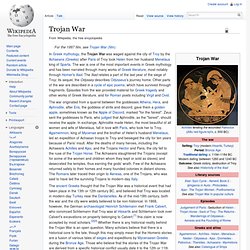
Greek mythology. Greek mythology is explicitly embodied in a large collection of narratives, and implicitly in Greek representational arts, such as vase-paintings and votive gifts.
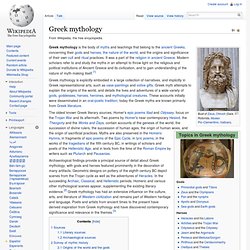
Greek myth attempts to explain the origins of the world, and details the lives and adventures of a wide variety of gods, goddesses, heroes, heroines, and mythological creatures. These accounts initially were disseminated in an oral-poetic tradition; today the Greek myths are known primarily from Greek literature. Archaeological findings provide a principal source of detail about Greek mythology, with gods and heroes featured prominently in the decoration of many artifacts.
Geometric designs on pottery of the eighth century BC depict scenes from the Trojan cycle as well as the adventures of Heracles. Sources Literary sources. Iliad. The Iliad (sometimes referred to as the Song of Ilion or Song of Ilium) is an ancient Greek epic poem in dactylic hexameter, traditionally attributed to Homer.
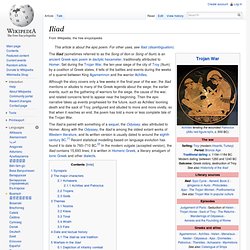
Set during the Trojan War, the ten-year siege of the city of Troy (Ilium) by a coalition of Greek states, it tells of the battles and events during the weeks of a quarrel between King Agamemnon and the warrior Achilles. Although the story covers only a few weeks in the final year of the war, the Iliad mentions or alludes to many of the Greek legends about the siege; the earlier events, such as the gathering of warriors for the siege, the cause of the war, and related concerns tend to appear near the beginning.
Then the epic narrative takes up events prophesied for the future, such as Achilles' looming death and the sack of Troy, prefigured and alluded to more and more vividly, so that when it reaches an end, the poem has told a more or less complete tale of the Trojan War. Synopsis[edit] Mythology. The Olympians. Mythological Figures. Heros of Greek Myth. Jason. Jason landing in Colchis - as depicted in a 17th-century painting.

Jason (Ancient Greek: Ἰάσων, Iásōn) was an ancient Greek mythological hero who was famous for his role as the leader of the Argonauts and their quest for the Golden Fleece. He was the son of Aeson, the rightful king of Iolcos. He was married to the sorceress Medea. Because he belongs to mythology, he may have existed before the Greek Dark Ages (1100-800 BC.) The people who wrote about Jason lived around 300 BC, during Antiquity. Argonauts. Story[edit] After the death of King Cretheus, the Aeolian Pelias usurped the Iolcan throne from his half-brother Aeson and became king of Iolcus in Thessaly (near the modern city of Volos).

Because of this unlawful act, an oracle warned him that a descendant of Aeolus would seek revenge. Perseus. Etymology[edit] Because of the obscurity of the name Perseus and the legendary character of its bearer, most etymologists pass it by, on the presumption that it might be pre-Greek; however, the name of Perseus’ native city was Greek and so were the names of his wife and relatives.
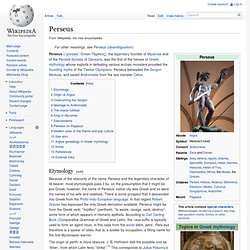
There is some prospect that it descended into Greek from the Proto-Indo-European language. In that regard Robert Graves has espoused the only Greek derivation available. Perseus might be from the Greek verb, "πέρθειν" (perthein), “to waste, ravage, sack, destroy”, some form of which appears in Homeric epithets. Medusa. In Greek mythology Medusa ("guardian, protectress")[1] was a monster, a Gorgon, generally described as having the face of a hideous human female with living venomous snakes in place of hair.
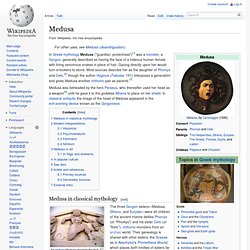
Gazing directly upon her would turn onlookers to stone. Most sources describe her as the daughter of Phorcys and Ceto,[2] though the author Hyginus (Fabulae, 151) interposes a generation and gives Medusa another chthonic pair as parents.[3] Medusa was beheaded by the hero Perseus, who thereafter used her head as a weapon[4] until he gave it to the goddess Athena to place on her shield. Odysseus. Odysseus (/oʊˈdɪsiəs, oʊˈdɪsjuːs/; Greek: Ὀδυσσεύς [odysˈsews]), also known by the Roman name Ulysses (/juːˈlɪsiːz/; Latin: Ulyssēs, Ulixēs), was a legendary Greek king of Ithaca and a hero of Homer's epic poem the Odyssey.
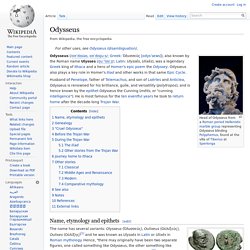
Odysseus also plays a key role in Homer's Iliad and other works in that same Epic Cycle. Husband of Penelope, father of Telemachus, and son of Laërtes and Anticlea, Odysseus is renowned for his brilliance, guile, and versatility (polytropos), and is hence known by the epithet Odysseus the Cunning (mētis, or "cunning intelligence"). He is most famous for the ten eventful years he took to return home after the decade-long Trojan War. Name, etymology and epithets[edit] The name has several variants: Olysseus (Ὀλυσσεύς), Oulixeus (Οὐλιξεύς), Oulixes (Οὐλίξης)[1] and he was known as Ulyssēs in Latin or Ulixēs in Roman mythology. Theseus. Theseus was a founder-hero, like Perseus, Cadmus, or Heracles, all of whom battled and overcame foes that were identified with an archaic religious and social order.[2] As Heracles was the Dorian hero, Theseus was a founding hero, considered by Athenians as their own great reformer: his name comes from the same root as θεσμός ("thesmos"), Greek for "The Gathering".
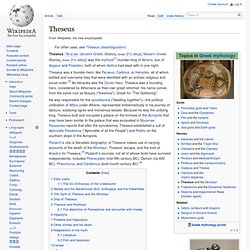
Plutarch's vita (a literalistic biography) of Theseus makes use of varying accounts of the death of the Minotaur, Theseus' escape, and the love of Ariadne for Theseus.[3] Plutarch's sources, not all of whose texts have survived independently, included Pherecydes (mid-fifth century BC), Demon (ca 400 BC), Philochorus, and Cleidemus (both fourth century BC).[4] Early years[edit] Thus Theseus was raised in his mother's land. When Theseus grew up and became a brave young man, he moved the rock and recovered his father's tokens. Minotaur. In Greek mythology, the Minotaur (/ˈmaɪnətɔː/,[1] /ˈmɪnəˌtɔr/;[2] Ancient Greek: Μῑνώταυρος [miːnɔ̌ːtau̯ros], Latin: Minotaurus, Etruscan Θevrumineś), was a creature with the head of a bull on the body of a man[3] or, as described by Roman poet Ovid, "part man and part bull".[4] He dwelt at the center of the Cretan Labyrinth, which was an elaborate maze-like construction[5] designed by the architect Daedalus and his son Icarus, on the command of King Minos of Crete.

The Minotaur was eventually killed by the Athenian hero Theseus. "Minotaur" was originally a proper noun in reference to this mythical figure. The use of "minotaur" as a common noun to refer to members of a generic race of bull-headed creatures developed much later, in 20th-century fantasy genre fiction. Birth and appearance[edit] The bronze "Horned God" from Enkomi, Cyprus. Heracles. Origin and character Heracles was the greatest of Hellenic chthonic heroes, but unlike other Greek heroes, no tomb was identified as his. Heracles was both hero and god, as Pindar says heroes theos; at the same festival sacrifice was made to him, first as a hero, with a chthonic libation, and then as a god, upon an altar: thus he embodies the closest Greek approach to a "demi-god".[8] The core of the story of Heracles has been identified by Walter Burkert as originating in Neolithic hunter culture and traditions of shamanistic crossings into the netherworld.[9] Hero or god Heracles' role as a culture hero, whose death could be a subject of mythic telling (see below), was accepted into the Olympian Pantheon during Classical times.
Labors of Hercules. Achilles. In Greek mythology, Achilles (/əˈkɪliːz/; Ancient Greek: Ἀχιλλεύς, Akhilleus, pronounced [akʰillěws]) was a Greek hero of the Trojan War and the central character and greatest warrior of Homer's Iliad. Achilles was said to be a demigod; his mother was the nymph Thetis, and his father, Peleus, was the king of the Myrmidons. Etymology[edit] Achilles' name can be analyzed as a combination of ἄχος (akhos) "grief" and λαός (Laos) "a people, tribe, nation, etc. " Ancient History.
Major League Social Studies. The Assassination of Osama Bin Laden. A Veteran of Bin Laden Assault Unit SEAL Team Six Describes His Training. “Some of you look sleepy. All of you drop and push ’em out!” After push-ups and more instruction, we went outside, where the sunshine had dimmed. Soon we stood by our boats facing the ocean. Bulky orange kapok life jackets covered our battle dress uniforms (BDUs). We tied our hats to the top buttonholes on our shirts with orange cord. Before long they returned and gave us orders. Losers would pay with their flesh—it pays to be a winner. “Ones in!” Our two front men jumped into the boat and started paddling. I ran in water almost up to my knees. “Twos in!” Two more jumped in and started paddling. “Threes in!” I jumped in with the man across from me, and we paddled. Stealth Helos Used In Osama Raid. Well, now we know why all of us had trouble ID'ing the helicopter that crashed, or was brought down, in the Osama raid.
It was a secretly developed stealth helicopter, probably a highly modified version of an H-60 Blackhawk. Photos published in the Daily Mail and on the Secret Projects board show that the helicopter's tail features stealth-configured shapes on the boom and tip fairings, swept stabilizers and a "dishpan" cover over a non-standard five-or-six-blade tail rotor. It has a silver-loaded infra-red suppression finish similar to that seen on some V-22s. No wonder the team tried to destroy it. Military Information. Stealth UH-60 Black Hawk revealed by Death of Osama bin Laden in Operation Neptune Spear. The elite team of US Navy SEALs could enter into Pakistani Airspace without being noticed and execute the raid that killed Osama bin Laden. Helicopters.
Helicopter Pilot Jobs. Helicopters: civil helicopter and military helicopter – Eurocopter, an EADS company. Helicopter Aviation. [Top] [Up] [Prev] [Next] Training to become a Helicopter Pilot If you are thinking about getting your helicopter license, there are a few things you may want to know first. Most people who decide to get their helicopter license break down into one of two categories. Someone who holds no pilot rating at all, or someone who holds some sort of fixed wing rating. Becoming A Helicopter Pilot. Whether seeking a career as a professional helicopter pilot or pursuing a private rotorcraft pilot’s license, flying helicopters is like nothing else you have ever done or will ever do.
And, it is never too late to begin. New people are entering the field every day-from their late teens to their 50s and older. And, it should go without saying-women pilots are every bit as welcome and have the same opportunities as men. Flying helicopters is exciting, challenging, empowering and just plain fun. Helicopter Pilot Career Overview. Advertise here. Justice & Law.